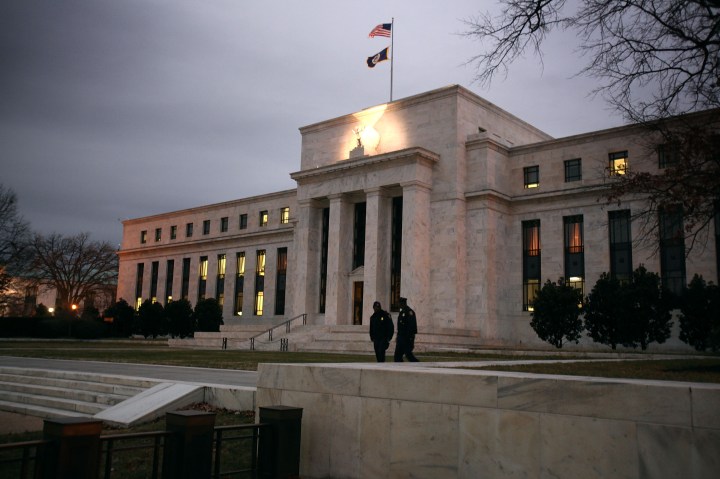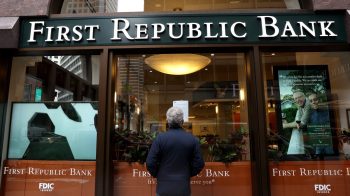
Could the Fed’s new emergency bank lending program encourage risky behavior?
Could the Fed’s new emergency bank lending program encourage risky behavior?

In the wake of the meltdowns of Silicon Valley Bank and Signature Bank, monetary policymakers quickly created a program to provide financial institutions in crisis a little wiggle room.
The Federal Reserve attached a rather boring name to a big new program: the Bank Term Funding Program. Its aim? To help certain eligible depositary firms — banks, credit unions etc. — have cash on hand for depositors through government loans at favorable rates. While the government says the program is necessary, some like Joseph Wang, chief investment officer at Monetary Macro, see it as a failure of a years-long campaign to improve the resilience of the banking sector.
“This is basically the biggest bailout to the banking sector since the [The Great Recession],” Wang said in an interview with Marketplace’s David Brancaccio. “In central banking, one of the basic tenets is you lend to solvent banks with good collateral at above-market rates because the role of a central bank, as we understand, is to be a lender of last resort. But that [new] bank facility, it breaks all those tenets.”
The following is an edited transcript of their conversation:
David Brancaccio: Setting aside for a moment U.S. authorities rescuing even the uninsured depositors at, for instance, Silicon Valley Bank, the Federal Reserve did something else in the name of bringing calm to the banking system, right? It’s called the Federal Reserve’s Bank Term Funding Program. That has you a little bit concerned?
Joseph Wang: Very concerned, actually, David. The way I look at this, this is basically the biggest bailout to the banking sector since the great financial crises. And I’ll tell you why. So I used to be a central banker, and in central banking, one of the basic tenets is you lend to solvent banks with good collateral at above-market rates because the role of a central bank, as we understand, is to be a lender of last resort. But that bank facility, it breaks all those tenets. The new bank lending facility by the Fed can lend to any commercial bank, there is no requirement to make sure that they’re solvent or not.
But the second point is really the big difference — they lend against face value instead of market value. So for example, if I bought a treasury security for $100, and then afterward, interest rates rose and the market value of those treasuries fell to $70, well, usually, I should only be able to borrow $70 against it, because that’s the market value of the collateral. But under the bank lending facility, I can go and take that $70, pledge it, and borrow $100. In a sense, the central bank is lending unsecured, it’s lending against collateral that is worth less than a loan. And as far as I understand, no central bank in the world does that. It’s very easily bad practice. And the third thing is that the interest rates that the loan facility is charging on these loans is either around market or most likely below market, because if you’re a bank in trouble, usually have to pay much higher interest rates than what the market is. And this facility is offering market rates that are basically at or below market. So it’s a very, very big departure from standard practice.
Brancaccio: Just so people understand, this new system is, “Hey, bank, if a lot of depositors come by for their money at once, and you can’t handle the sudden flow, you banks can borrow from us, the central bank, automatically to cover things like the bonds in your portfolio.” But they’re government bonds — if you hold them to maturity, they’ll be worth the full amount. Isn’t this Fed system just helping those banks buy some time?
Wang: Well, one of the basic principles of any bank is to manage interest rate risk. You have longer-dated assets ensuring the liabilities. Now a bank has to manage both their assets well, so that they don’t have too much interest rate risk, but also their liabilities as well such that if you won’t have all these depositors come in ask for their money back at the same time. And they have a lot of tools to do this. And as you can see, as the Fed raised rates, the banking system as a whole was fine. But to your point, interest rate risk is an important component of any asset management. What you’re doing is you’re basically socializing that away. And so in a sense, it’s a huge transfer of risk away from the banking sector onto the public sector.
Brancaccio: And you object to it philosophically, but it sounds like you also object to it in a practical sense. Why is it a problem beyond the philosophical objection?
Wang: What you’re really doing right now is, in a sense, you are allowing banks to not have to worry about their interest rate risk. And that encourages, I think, irresponsible behavior. The way that a market economy works is that if a business does a good job, we want it to succeed. And if a business does a bad job, we don’t want it to succeed. But what we’re doing right now is we’re saying that you can go and, you know, you don’t even have to care about your interest rate risk at all. And what we’re suggesting, too, is you don’t have to worry about your depositors as well because the Fed or the government will bail them out. There’s really no way a bank can fail. And so they’re encouraged, then, to go and make a lot of long-duration investments, or to make irresponsible loans, go bust, and then their depositors will just get bailed out.
Brancaccio: I can see, I mean, if Bank X is poorly run and has made risky choices, you would like to see it get a comeuppance. But the thing with banking is there can be this contagion. And you could get other people worried about other banks that are practicing safer practices affected by the first bank’s predicament, and it ruins it for everybody. And then you have like an insurance policy like the Fed is offering here with this bank term funding program.
Wang: You’re exactly right. Bank contagion is very real, because in part because there’s a big psychological component to this. If you’re a depositor and you see one bank fail, you might get worried and start to withdraw money from your own bank, and your own bank, even though it’s fine, just can’t handle all that. So this is an age-old problem, and was a particularly big problem in the great financial crisis, when we actually had many important banks fail. The regulators have come up with many solutions to this. One obvious one is deposit insurance, for example, but the biggest change since the great financial crisis to prevent bank runs is that we’ve made the banking sector a lot safer. There have been tremendous, tremendous changes to the banking sector. The first, for example, is that the Fed has put a lot more cash in the banking sector. And after Dodd-Frank and Basel III, the banks are highly, highly regulated. So I think the banking system today is much stronger than it was before. And so it would have been able to withstand the failure of a regional bank without having runs.
Brancaccio: Of course, some of the challenge here is that some of these smaller banks, these regional banks, thought that they were different, didn’t pose a systemic risk and won exemptions for themselves from some of the stiffer regulation.
Wang: Yes, that’s exactly right. And so it looks like they kind of paid for the price of their own lobbying, right? So in the regulatory rules, you want to have less than $250 billion in assets to stay under lighter regulation. And it seems like there was some effort by some of these regional banks to manage their bank so that they stayed under the more stringent efforts. And since they were not under more stringent regulation, it seems they behaved in a way that was not good business practice. And one of them, Silicon Valley Bank, failed. But for the broader contagion risk, though, you have to realize that these regional banks are not a big part of the banking system. And for example, Silicon Valley Bank was only one tenth the size of JPMorgan. These are basically not a big part of the banking sector. So the broader banking sector is very strong, and it’s very difficult to run on them even if you have smaller banks failing because of deposit insurance and because of more stringent regulations. And I would also note that if you are a small bank, most of your depositor base is insured. So there’s much less of an incentive to run. Silicon Valley Bank, who is in our memory right now was very uncommon in that almost all of its deposits were uninsured. Now, if you are an uninsured depositor, you are very worried and you take your money out ASAP. But for everyone else, and for most banks who have a very diversified depositor base, it’s unlikely for there to be a run because so much of the deposit base is insured.
Brancaccio: Now economists love to talk about, and we have been just talking about, moral hazard. You take it in Econ 101: are you more likely to drive like a knucklehead if there’s a financial safety net out there for you — car insurance. You think this new Bank Term Funding the Fed is doing — where banks can borrow easily — if depositors come wanting their money quickly, you think that encourages bad behavior?
Wang: I do. I think there is a moral hazard aspect to this. And these are things that are difficult to see right now but have longer-term consequences. Right now, it seems like it’s great that we saved these people, and believe me, I want everyone to be happy and so forth. But if we have these moral hazard issues and we encourage bad behavior, over the greater span of time, we make poorer decisions, our banking system doesn’t become healthier and our economy doesn’t become healthier as well. In order to have them be healthy, we have to encourage good practices and discourage bad practices.
There’s a lot happening in the world. Through it all, Marketplace is here for you.
You rely on Marketplace to break down the world’s events and tell you how it affects you in a fact-based, approachable way. We rely on your financial support to keep making that possible.
Your donation today powers the independent journalism that you rely on. For just $5/month, you can help sustain Marketplace so we can keep reporting on the things that matter to you.


















